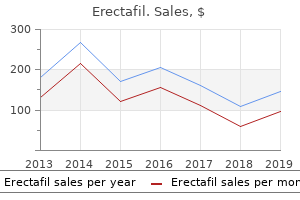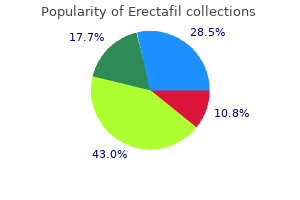Erectafil
"Purchase erectafil 20 mg visa, erectile dysfunction exam video".
By: G. Owen, M.B. B.A.O., M.B.B.Ch., Ph.D.
Clinical Director, Dartmouth College Geisel School of Medicine
The different model was called Multiregionalism or the Multiregional Continuity model impotence 2 purchase genuine erectafil on-line. The view of the info by scientists on this facet was that fashionable Homo sapiens developed from the archaic people in Africa erectile dysfunction exercises dvd buy cheap erectafil 20 mg line, Europe erectile dysfunction ear order erectafil without a prescription, and Asia concurrently (Wolpoff 1989). Gene circulate would have stored the species cohesive across the nice distance while producing native variation as well. The multiregionalist experts pointed to the sharing of traits from Homo erectus, via archaic Homo sapiens, after which to the modern people in several parts of the world as supporting their model. For instance, in Europe the Oase fashionable people possessed Neanderthal-like traits and sure fashionable people possess alleles that came from Neanderthals and Denisovans. Taking the supported parts of each model and mixing them formed a proof that was more difficult, but defined rather more of the scientific proof. The merging of two models to type a better one fits the name of the improved version: the Assimilation model. The Assimilation model proposes that fashionable Homo sapiens developed in Africa first and expanded out (from the Out of Africa model) but also interbred with the archaic Homo sapiens they encountered outdoors Africa (from the Multiregionalism model) (Figure 12. True multiregionalism occurred just inside Africa because the species developed from an online of interactions between diversified teams (Scerri et al. As the modern human population expanded from Africa, they assimilated the alleles of archaic people they encountered via interbreeding. Having developed from Homo erectus, the archaic people expanded from Africa and established the Neanderthal and Denisovan teams. In Africa, the remaining archaic people developed the modern set of traits and expanded from the continent as well, encountering and interbreeding with two archaic teams across Europe and Asia. While scientific progress has produced a model that satisfies the info, there are still lots of questions for paleoanthropologists to answer relating to our origins. How did biological, cultural, and environmental factors affect the material culture found in several parts of the world? The definitive clarification of how our species started and what our ancestors did is still out there to be found. Special Topics: "Cavemen" in Popular Culture "Cavemen," or our prehistory generally, is a continuing presence in western popular culture. The prehistoric experience even will get interactive with video games like Far Cry Primal where the participant can persistence-hunt for meals and ride a woolly mammoth (! The distant past has also been the setting for more comedic stories, such because the Flintstones and, just lately, the Croods with Nicolas Cage. Experiencing our imaginings of that point could fulfill parts of our brain that developed in that scenario, just as people accustomed to urban life discover enjoyment by tenting or sitting around a fire with family and friends. Seeing the portrayal of the prehistoric world could reach these parts of our psychology that really feel at home away from our constructed surroundings. There is a significant lag time between the scientific view of our past and when it reaches mass media. Even in latest productions, prehistoric individuals are dim-witted and have restricted vocabulary, though the proof exhibits that our brains and language abilities are basically the identical at present as 300,000 years in the past. How our media choose to represent the past could say more about our own values and views of ourselves rather than what people had been really like long ago. While the sport is about at 12 kya, one faction of people has distinctly Neanderthal traits (center-left), though none had been left by that point in reality. Instead of a refrigerator or pantry stocked with meals, we procured diet and different resources as needed based mostly on what was available within the surroundings. Instead of accumulating and displaying stuff, we stored our possessions at a minimum for mobility. This half offers an summary of how this foraging life-style enabled the Modern Homo sapiens 471 enlargement of our species, then describes the invention of a new lifestyle, inflicting a sequence reaction of cultural change taking us to the current day and past. The Foraging Tradition To understand our species is to understand foraging, or the search for resources within the surroundings. This subsistence strategy, or technique of discovering sustenance, sounds uncommon to most of us at present. For occasion, our environment friendly bipedalism allows persistence-looking across long distances as well as movement from useful resource to useful resource.

Wild Succulent Cactus (Caralluma). Erectafil.
- Weight loss and obesity, quenching thirst, and increasing endurance.
- How does Caralluma work?
- Dosing considerations for Caralluma.
- Are there safety concerns?
- What is Caralluma?
Source: http://www.rxlist.com/script/main/art.asp?articlekey=97104
Diseases
- Maroteaux Stanescu Cousin syndrome
- Short bowel syndrome
- Sutton disease II
- Charcot Marie Tooth disease, X-linked type 3, recessive
- Chromosome 1, monosomy 1p34 p32
- Mulibrey nanism

Surgical biopsy erectile dysfunction treatment with homeopathy erectafil 20 mg on-line, with special emphasis on the eyelids and conjunctiva erectile dysfunction caused by obesity purchase erectafil 20mg without prescription, cornea impotence group order erectafil 20mg visa, and vitreous** b. Describe fundamental info essential to talk to the ophthalmic pathologist relating to examine of these specimens. Describe widespread indications for frozen sections in ophthalmic pathology (eg, full resection margins in basal and squamous cell carcinoma, demonstration of lipid in sebaceous gland carcinoma). Describe fundamental steps in handling and processing of gross specimens within the ophthalmic pathology laboratory via a website go to, with relevance to ophthalmic surgical procedure. Process specimens for submitting to an ophthalmic pathology laboratory, and write the accompanying letter to the ophthalmic pathologist (eg, surgical biopsy, corneal button, enucleated eye, exenteration specimen). Read and interpret reviews from these specimens written by the ophthalmic pathologist. Participate as an observer via a website go to within the macroscopic and microscopic examination of ophthalmic pathology specimens from lively cases. Standard Level Goals: Year 2 and Year three these objectives relate to the second and third years of ophthalmic residency training. Describe more superior ocular anatomy (eg, widespread variants), and determine the histology of the most important buildings of the eye and its adnexa relevant to particular medical rotation(s) (eg, oculoplastics, cornea, glaucoma, retina, ophthalmic oncology). Describe the pathophysiology and determine the most important histologic findings of widespread diseases of the eye (eg, keratitis, exfoliation syndrome, corneal and retinal dystrophies and degenerations, frequent neoplasms) relevant to particular medical rotation(s) (eg, oculoplastics, cornea, glaucoma, retina, ophthalmic oncology). Describe the pathophysiology and histology of probably vision or life-threatening diseases (eg, temporal arteritis, endophthalmitis, retinoblastoma, ocular melanoma, extraocular or orbital spread of an intraocular or periorbital tumor, metastasis to the eye and orbit) relevant to particular medical rotation(s) (eg, oculoplastics, cornea, glaucoma, retina, ophthalmic oncology). Describe and interpret reviews of more superior methods in ophthalmic histopathology (eg, cytology, special stains, transmission electron microscopy, immunohistochemistry, tumor free margins) relevant to particular medical rotation(s) (eg, oculoplastics, cornea, glaucoma, retina, ophthalmic oncology), together with how the clinician communicates the necessity for these studies. Process appropriately more superior specimens for submitting to an ophthalmic pathology laboratory, together with writing of the accompanying letter to the ophthalmic pathologist (eg, impression cytology, fantastic needle aspiration biopsy, vitreous biopsy, evisceration, exenteration specimen). Participate beneath supervision via a website go to in a macroscopic and microscopic examination of ophthalmic specimens from lively cases, working from low to excessive energy. Advanced Level Goals: Year 2 and Year three these objectives relate to the second and third years of ophthalmic residency training, for residents with a special interest in ophthalmic pathology. Describe less widespread ocular anatomy (eg, pars plana cysts), and determine the histology of the minor buildings (eg, ciliary sulcus) of the eye and its adnexa relevant to particular medical rotation(s) (eg, oculoplastics, cornea, glaucoma, retina, ophthalmic oncology). Describe the pathophysiology of less widespread disease processes of the eye (eg, most common syndromes, less widespread corneal and retinal dystrophies and degenerations and ocular neoplasms, ocular lesions in acquired immune deficiency syndrome) relevant to particular medical rotation(s) (eg, oculoplastics, cornea, glaucoma, retina, ophthalmic oncology), and determine their main histologic findings. Describe and interpret reviews of superior methods in ophthalmic pathology (eg, flow cytometry, molecular genetics) relevant to particular medical rotation(s) (eg, oculoplastics, cornea, glaucoma, retina, ophthalmic oncology). Participate as an "at-the-elbow" observer throughout microscopic examination of lively ophthalmology cases, together with special stains. Participate in gross examination and chopping of widespread ophthalmic pathology specimens (eg, eyelid biopsies, corneas, entire globes), and take macroscopic and microscopic pictures to document pathologies. Prepare a fundamental histologic specimen (eg, hematoxylin-eosin stain) for review by the ophthalmic pathologist. Perform microscopic examination of a specimen beneath supervision, and take part in writing the report, ideally previewing slides upfront of the pathologist to come up with a prognosis and to counsel special stains and immunohistochemistry with out the affect of the ophthalmic pathologist, followed by reviewing the report and special stain orders with the latter. Very Advanced Level Goals: Subspecialist these objectives relate to, but build upon and are more superior and distinct from, the second and third years of ophthalmic residency training. Describe superior ocular anatomy, and determine histology of the minor buildings of the eye and their unusual variants (eg congenital grouped pigmentation). Describe the histology of the less widespread but doubtlessly vision or life-threatening ocular and adnexal diseases (eg, healed large cell arteritis, mimics and masqueraders of inflammation and neoplasm, less widespread benign and malignant neoplasms). Describe ancillary procedures for oncology (eg, bone marrow aspiration, cerebrospinal fluid cytology). Manage consultation between the clinician and ophthalmic pathologist relating to indications for special stains (eg, Gram stain for micro organism, Congo purple for amyloid; Gomori methenamine silver staining for fungi; Prussian blue for hemosiderosis; von Kossa for calcium; Oil Red O or Sudan Black for sebaceous carcinoma) or processing (eg, orientation of specimen, special handling). Participate as an observer through the microscopic examination of lively ophthalmology cases, together with more superior stains and methods.
